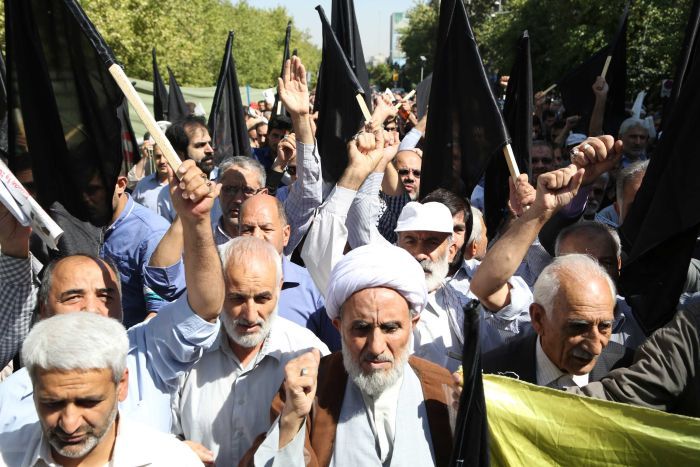Saudi authorities have been blamed for the stampede during the Hajj pilgrimage which killed at least 717 people, in the worst tragedy to strike the annual Muslim pilgrimage in a quarter-century.
The disaster, which also injured several hundred people, was the second deadly accident to hit worshippers this month, after a crane collapse in Mecca killed more than 100.
The stampede broke out in Mina, about five kilometres from Mecca, during the symbolic “stoning of the devil” ritual.
Hajj deaths by nationality
Algeria: 4
Benin: deaths confirmed but number unspecified
Burundi: 1
Cameroon: 20
Chad: 11
Egypt: 14
Iran: 131
India: 14
Indonesia: 3
Kenya: 3
Morocco: 87 (according to state media)
Netherlands: 1
Niger: 19
Nigeria: 3
Pakistan: 7
Senegal: 5
Somalia: 8 (according to local media)
Tanzania: 4
Saudi authorities have yet to provide an official breakdown, but several foreign countries and their media have announced the deaths of nationals. Source: AFP
Saudi Arabia categorically denied reports the crush happened after roads were closed to let a convoy of dignitaries through.
The Saudi Interior Ministry said the claim was malicious and untrue and Iranian state media appeared to have started the rumour.
Iran, which said 131 of its nationals were among the victims, accused regional rival Saudi Arabia of safety errors and organised an anti-Saudi demonstration over what it said were flawed safety measures that led to the tragedy.
“Saudi Arabia is incapable of organising the pilgrimage,” said Ayatollah Mohammad Emami Kashani, leading the main weekly Muslim prayers in Tehran.
“The running of the Hajj must be handed over to Islamic states.”
Saudi Arabia’s King Salman earlier ordered “a revision” of how the Hajj is organised, state news agency SPA said, so that pilgrims could “carry out their rituals in complete safety”.
A formal inquiry is underway.
Iran’s first vice president Eshaq Jahangiri said other nations should have a role in the investigation.
“Countries such as Iran, which have suffered so much, should be represented in the inquiry to determine the causes of the catastrophe and to gain assurances that it will not be repeated in the future,” he said.
After the prayers in Tehran, worshippers held a protest against the “mischievous and incompetent regime” in Riyadh, said the Islamic Propagation Coordination Council which organises state-sponsored demonstrations in Iran.
Shiite Iran and Sunni Saudi Arabia are bitter rivals whose relations are already strained by regional conflicts from Syria to Yemen.
The custodianship of the Muslim holy places forms a key plank in the Saudi monarchy’s claims to legitimacy.
Pilgrims at the scene in Mina faulted Saudi authorities and some said they were afraid to carry on with the Hajj rituals.
However, they said security had improved and the crowd was smaller.
Special emergency forces were heavily deployed across Mina with dozens of troops at every level of the five-storey bridge used for the stoning ritual in which pebbles are thrown at pillars.
How does a stampede happen?
The deaths of hundreds in a stampede during the annual Hajj pilgrimage raises the question: how does a stampede happen, especially during a peaceful religious gathering?
A Kenyan survivor who returned to the pillars on Friday said his group lost three people.
“I can blame the Saudi government because they did not control [the situation]. I was there. I survived,” Isaac Saleh said.
Aminu Abubakar, an AFP correspondent who was among the pilgrims when the stampede occurred, said there was no room to manoeuvre. He escaped the crush of bodies because he was at the head of a procession.
Fellow pilgrims told him of children dying despite parents’ efforts to save them near the sprawling tent city where they are lodged.
“They threw them on rooftops, mostly tent-tops … Most of them couldn’t make it,” Abubakar said.
Saudi Arabia ‘capable of managing Hajj’, health minister says
During weekly prayers at Mecca’s Grand Mosque, Sheikh Saleh al-Taleb defended the kingdom which, he said, “is capable of managing Hajj affairs” without outsiders suggesting they can do better.
“It is unacceptable to ignore all the efforts” the kingdom has made to improve infrastructure at the holy sites, he said.
Saudi health minister Khaled al-Falih, whose country has spent billion of dollars on safety measures at the Hajj, blamed worshippers themselves for the tragedy.
He told El-Ekhbariya television that if “the pilgrims had followed instructions, this type of accident could have been avoided”.
Pilgrims, however, blamed the closure of roads and poor management of the flow of hundreds of thousands of pilgrims in searing temperatures.
“People were stumbling, falling, trying to get up. They were dehydrated, getting disorientated, they were dying in front of our eyes,” witness Zaid Bayat said.
“They were suffocating. We tried to help revive them, but for every person you were helping there were 13, 14 others just falling down.”
Foreign Affairs Minister Julie Bishop extended the Australia’s condolences to the families of those killed in the Hajj pilgrimage stampede.
In a statement Ms Bishop said she was deeply saddened to hear of the tragedy and terrible loss of life.
Saudi authorities said they did not know of any Australians who had been affected.
Gallery: Muslims travel to Mecca for the Hajj pilgrimage









1 Comments
Tara Nath Ghimire
Allah, eh ?